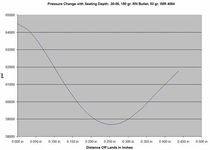Yeah, there's a reason testing is typically done at short range. Environmental effects will add significant dispersion to your groups at longer ranges, especially over a 60rd course of fire. You also have barrel heat, and shooter fatigue to consider.
Now, 30rd groups are certainly more statistically robust and useful for distinguishing small differences, but they need to be 30 "perfect" shots, as in no other variables changing during the courses of fire. Very hard to achieve that level of consistency without machines and indoor ranges, which is why that type of testing is usually done with machines and indoor ranges!
Once again I'll advocate for using shot radius, mean shot radius, and the T-test to more rigorously assess different samples. This post has an example of how I do this:
https://rokslide.com/forums/threads/what-did-you-do-in-the-reloading-room-today.338563/post-4125326.
You'll note in that test I did not see any significant effect from seating depth, and
I made a very drastic change with a secant ogive bullet.
I do think that seating depth can matter for loose chambers with long freebore, where the bullet is jumping truly unsupported for a significant distance before engaging the lands and can develop yaw before engraving which will manifest as increased dispersion on target. For instance, a SAAMI 308 chamber has a 0.310" freebore, meaning there is 0.001" clearance around the bullet on all sides. Compare this to a 6.5CM SAAMI chamber with a 0.2645" freebore, or 0.00025" clearance around the bullet on all sides, effectively a light interference fit. This will constrain the bullet much more tightly and prevent it from developing any appreciable yaw even with a very long jump. So you might find different results testing in different chambers with different bullets and jumps.


